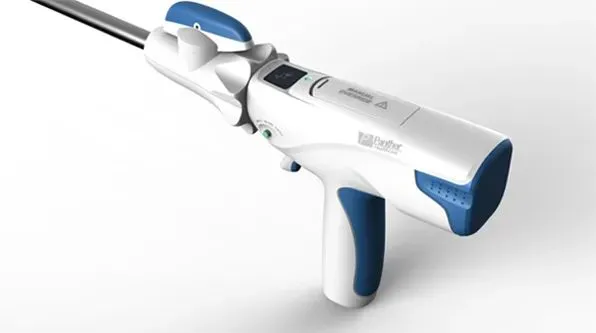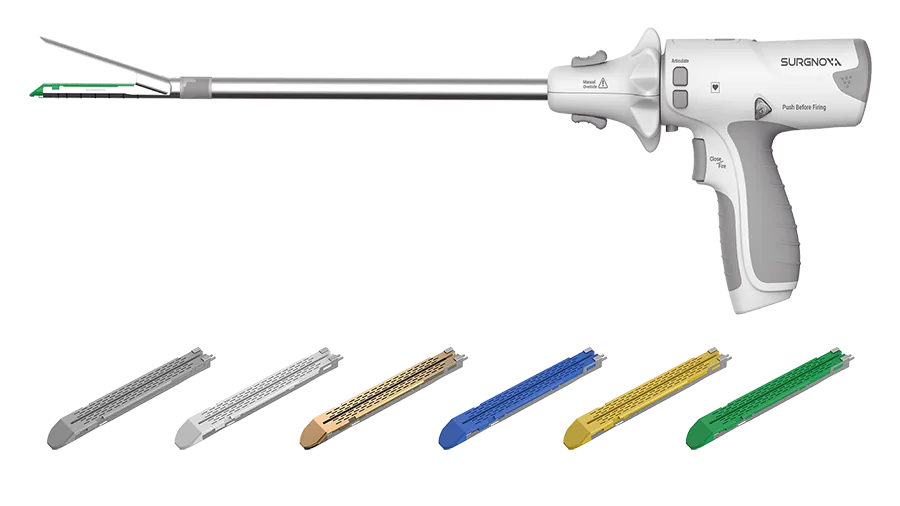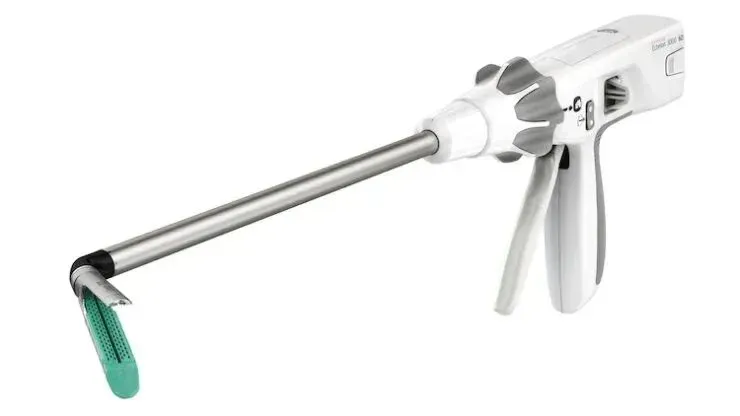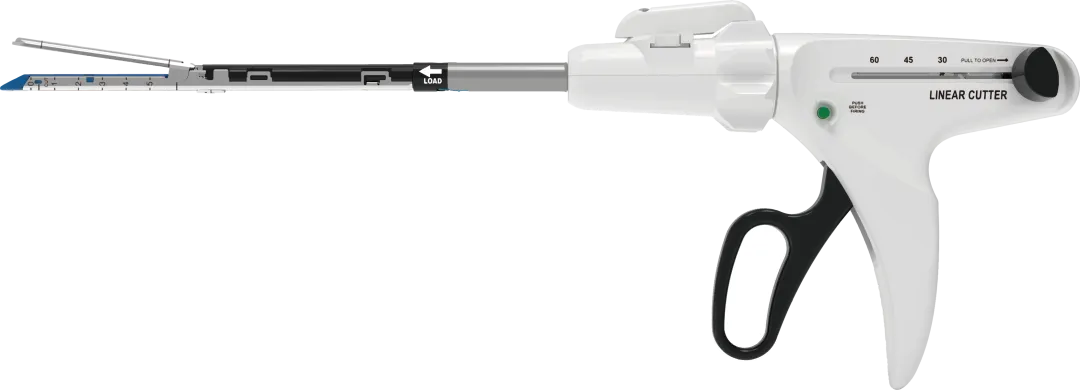Stapler Medical Device Industry Market Analysis Report
Mar 25, 2025医疗IP君 医械知识产权 2025年03月06日 08:28 江苏
The global surgical staplers market size is valued at USD 4.5 billion in 2024 and is expected to reach USD 8.7 billion by 2032, at a compound annual growth rate (CAGR) of 7.5% during the forecast period.The strong market growth is mainly driven by the increase in the number of surgeries worldwide and the advancement of surgical anastomosis techniques.
A key growth factor for the surgical staplers market is the rising incidence of chronic diseases requiring surgical intervention.
Conditions such as obesity, cardiovascular diseases, and various cancers are on the rise, leading to an increase in the number of surgeries. The aging of the global population contributes significantly to the demand for surgical staples, as older people are more likely to undergo surgery. This demographic shift ensures a steady demand for surgical staplers, thereby boosting the market growth.
Advancements in surgical stapler technology also play a major role in the market expansion.
Innovative products such as electric surgical staplers are gaining widespread use, offering greater precision and control than manual staplers.These devices can minimize the risk of complications during surgery, reduce operating time, and improve overall surgical outcomes.Additionally, the growth in minimally invasive surgical techniques that rely on advanced stapling devices is further driving the market.Rising healthcare expenditure in developed as well as developing countries is also a significant contributor to the growth of the surgical staplers market.Government and private entities are investing heavily in healthcare infrastructure, resulting in better-equipped hospitals and surgical centers.This improved infrastructure has facilitated the use of advanced surgical tools, including surgical staplers.Furthermore, favorable reimbursement policies in many regions have made these devices more accessible to healthcare providers, thereby driving market growth.
In terms of regional outlook, North America currently holds the largest share of the surgical staplers market owing to its high surgical rate and presence of major market players.However, Asia Pacific is expected to witness the highest growth rate during the forecast period.
This is due to the improving healthcare infrastructure, growing medical tourism, and increasing awareness about advanced surgical tools, which has led to rapid market expansion in the region.Europe also presents promising growth opportunities given its well-developed healthcare system and continued advancement in medical technology.

market segmentation
type analysis
The surgical staplers market is segmented into reusable and disposable surgical staplers.
Reusable surgical staplers are designed to be used multiple times and can be used again after proper sterilization.
These devices are very durable and cost-effective in the long run, making them a popular choice for healthcare providers who perform a high volume of surgeries.They are particularly popular in developed regions with extensive sterilization capabilities. However, the initial cost of reusable staplers is high, which can be a limiting factor in smaller clinics or healthcare facilities in developing countries.
On the other hand, disposable surgical staplers are designed for single use, eliminating the need for sterilization and reducing the risk of cross-infection between patients.
These staplers are gaining popularity in the market due to their convenience and safety features. The demand for disposable staplers is particularly high in regions with strict infection control regulations.
The choice between a reusable or disposable stapler often depends on several factors, including the type and volume of surgeries, budgetary constraints, and regulatory guidelines.While reusable staplers offer long-term cost savings and are environmentally friendly, disposable staplers provide unmatched convenience and compliance with infection control standards.Both product types have their unique advantages, and their market demand dynamics are influenced by changing medical needs and technological advances.
Technological innovation is also shaping the surgical stapler market.For example, some reusable staplers are now equipped with advanced features such as integrated sensors that can provide real-time feedback during the procedure.These innovations are designed to improve surgical precision and patient outcomes.Similarly, disposable staplers are being developed using biodegradable materials to address environmental concerns.As technology continues to evolve, both reusable and disposable staplers are expected to witness significant advancements, further driving their use in the surgical field.
Application analysis
The application of surgical staplers covers a variety of surgical operations, including abdominal surgery, gynecological surgery, cardiac surgery, orthopedic surgery, etc.
Abdominal surgery is one of the largest segments, driven by the high incidence of gastrointestinal diseases, colorectal cancer, and bariatric surgery.In surgery, staplers are widely used for tissue docking and anastomosis, providing speed and efficiency compared to traditional suturing methods.
Gynecological surgery is another important application area, including procedures such as hysterectomy, myomectomy and pelvic organ prolapse repair.Increasing incidence of gynecological disorders coupled with advancements in minimally invasive surgical techniques is driving the demand for surgical staplers in this segment.These devices help reduce surgical time and improve surgical outcomes, making them the preferred choice of gynecologists.
Cardiac surgery represents a key application area, given the rising incidence of cardiovascular diseases worldwide.
Surgical staplers are used in procedures such as coronary artery bypass grafting (CABG) and heart valve replacement.
The precision and reliability provided by staplers are crucial in cardiac surgery, as even small errors can have serious consequences.Technological advances in powered surgical staplers have been particularly beneficial in this area, providing greater control and reducing the risk of complications.
In orthopedic surgery, surgical staplers are used for wound closure and tissue fixation.The increase in the number of joint replacement surgeries, spinal surgeries, and sports-related injuries is driving the demand for surgical staplers in this segment.These devices offer the advantage of fast and safe closure, which helps patients recover faster. In addition, the development of specialized staplers for orthopedic applications is further driving the market growth.
Other applications for surgical staplers include thoracic surgery, urological surgery, and neurosurgery.The versatility of these devices makes them indispensable in a variety of surgical specialties.As the number of surgeries continues to increase and surgical techniques advance, the application scope of surgical staplers is expected to become more extensive, thereby driving the growth of the overall market.
Dynamic analysis
The surgical staplers market is segmented into manual and electric surgical staplers based on their mechanism.
Manual surgical staplers are operated by hand and require the surgeon to apply physical force to close the staples.
These staplers are simple to use, cost-effective, and widely available, making them particularly useful in resource-poor settings where advanced surgical tools are unavailable.
However, reliance on manual force can sometimes lead to inconsistent staple formation, compromising surgical outcomes.
Electric surgical staplers, on the other hand, are powered by batteries or electricity, providing consistent force and precision.These staplers are designed to reduce the physical effort required by the surgeon, thereby minimizing fatigue during long and complex surgical procedures.Electric staplers offer greater control and accuracy, leading to improved surgical outcomes and reduced risk of complications.
The adoption of electric staplers is growing rapidly, especially in developed regions where advanced technology is readily available.
The choice between a manual or powered stapler usually depends on the complexity of the procedure and the surgeon's preference.Manual staplers are suitable for simple surgeries with low precision requirements, while electric staplers are more suitable for complex surgeries that require high precision and control.
With the rising focus on improving surgical efficiency and patient safety, the adoption of electric staplers is increasing and is expected to grow significantly over the forecast period.
Technological advances are also affecting the mechanics of surgical staplers.For example, some electric staplers now come with integrated sensors that provide real-time feedback on tissue thickness and staple formation.These features help optimize the anastomosis process and improve surgical outcomes.Additionally, developments in ergonomic design and lightweight materials are improving the usability of both manual and powered staplers, making them more comfortable and easier to use for surgeons.
The ongoing research and development activities in the field of surgical staplers are expected to bring about new innovations and further refine their mechanisms.As healthcare providers increasingly recognize the advantages of powered staplers in terms of precision and efficiency, the demand for these advanced devices is likely to surge, thereby driving the overall market growth.
User analysis
End users of surgical staplers include hospitals, ambulatory surgical centers (ASCs), clinics, and other institutions.
Hospitals accounted for the largest share of the market owing to the high number of surgeries performed in these locations.The hospital is equipped with advanced surgical tools and has the infrastructure required to support complex surgeries.The presence of skilled surgeons and comprehensive medical services further promote the use of surgical staplers in hospitals.Furthermore, the increase in the number of multi-specialty hospitals is also driving the growth of this segment.
Ambulatory surgical centers (ASCs) are also emerging as important end users of surgical staplers.ASCs offer a more convenient and economical alternative to hospital surgery and have become a popular choice for outpatient surgery.
The rising trend of minimally invasive surgeries, which can be performed in ASCs, is driving the demand for surgical staplers in this segment.ASCs are equipped with advanced surgical tools and provide an environment suitable for performing various surgical procedures, making it a significant market segment.
Clinics, especially specialized surgical clinics, are another important surgical stapler end-user segment. These clinics focus on a specific type of surgery, such as plastic surgery, orthopedic surgery, or gynecological surgery.The adoption of surgical staplers in clinics is driven by the need for precision and surgical efficiency.Clinics often serve a large number of patients and require reliable surgical tools to ensure optimal outcomes.The growth in the number of specialized clinics is also driving the growth of this segment.
Other end users of surgical staplers include research and academic institutions, military medical facilities, and veterinary clinics.Research and academic institutions use surgical staplers for training and experimental procedures.Military medical institutions require rugged and reliable surgical tools to meet the medical needs of soldiers in different environments.Veterinary clinics are using surgical staplers to perform animal surgeries due to the increase in pet ownership and the increased emphasis on animal health.The diversity of end users demonstrates the wide range of applications and versatility of surgical staplers in different medical settings.
With the increasing focus on improving surgical outcomes and patient safety, the adoption of advanced surgical tools including surgical staplers is also increasing across all end-user segments. As healthcare providers continue to invest in improving their surgical capabilities, the demand for surgical staplers is expected to continue to grow over the forecast period.

market factors
The surgical staplers market presents several growth opportunities. A key opportunity lies in the development of advanced stapler technologies that can improve surgical precision and patient outcomes.Innovations such as electric surgical staplers, biodegradable staplers, and staplers with integrated sensors are expected to drive market growth.These advanced devices offer greater control, reduce the risk of complications, and provide real-time feedback, making them highly valuable during complex surgical procedures.Continuous research and development activities in the field are likely to lead to new and improved anastomotic solutions, creating significant growth opportunities for market players.
Another promising opportunity is the expansion of healthcare infrastructure in emerging markets.Countries in the Asia Pacific, Latin America, and the Middle East and Africa are investing heavily in health facilities and services.
Increasing healthcare expenditure coupled with rising awareness regarding advanced surgical tools is driving the demand for surgical staplers in these regions.The growing medical tourism industry in countries like India, Thailand, and Mexico is also contributing to the market growth.Healthcare providers in these regions are adopting surgical staplers to enhance their surgical capabilities and attract international patients, thereby creating lucrative opportunities for market expansion.
Despite the growth opportunities, the surgical staplers market faces several restraining factors.A major challenge is the high cost of advanced surgical staplers, especially electric staplers.These devices are more expensive than manual staplers and can be a limiting factor for healthcare facilities with limited budgets.The initial investment required for electric staplers may prevent smaller clinics and hospitals, especially in developing countries, from adopting these advanced devices.Furthermore, specialized training is required to operate an electric stapler, which may also be a barrier to its widespread adoption.Addressing these challenges will require efforts to reduce costs and provide adequate training for healthcare providers.
Regional Insights
Currently, North America dominates the surgical staplers market and holds the largest market share.The region’s dominance is attributed to high surgical rates, advanced healthcare infrastructure, and presence of major market players.In 2024, North America accounted for approximately 40% of the global market.The United States, in particular, has become an important contributor to the regional market due to its well-developed healthcare system and high healthcare expenditure.The region is expected to maintain its leading position at a steady CAGR of approximately 6.5% during the forecast period.
Europe is another important surgical staplers market, accounting for a considerable share of the global market.
The well-developed healthcare system in the region along with continuous advancements in medical technologies are driving the market growth.Countries such as Germany, France, and the UK are the major contributors to the European market.
Rising incidence of chronic diseases coupled with increasing number of surgeries is driving the demand for surgical staplers in the region. Europe is expected to witness steady growth at a CAGR of approximately 6.0% during the forecast period.
Asia Pacific is expected to experience the highest growth rate in the surgical staplers market during the forecast period.The rapid market expansion in the region is driven by improving healthcare infrastructure, increasing medical tourism, and rising awareness about advanced surgical tools.Countries such as China, India, and Japan are leading the growth in this region.The increase in the number of hospitals and surgical centers coupled with favorable government initiatives to improve healthcare delivery have contributed to the growth of the market. The Asia Pacific region is expected to grow at a strong CAGR of about 8.0% during the forecast period.

market competition
Leading market players are focusing on various strategic initiatives such as mergers and acquisitions, collaborations, and partnerships with other organizations to expand their global reach and offer a diverse range of products to their clients.New product launches, technological innovations, and geographical expansion are the major market development methods used by market players to increase market penetration.In addition, the medical device industry is witnessing a growing trend of local manufacturing to reduce operating costs and provide more cost-effective products to customers.The competitive landscape of the staplers market consists of several key players, each of which is improving its market position through innovation, strategic partnerships, and geographical expansion.The market is highly competitive, with companies focused on developing novel products and technologies to meet the evolving needs of healthcare providers and patients.Continued research and development efforts are critical to maintaining a competitive advantage to improve surgical outcomes and patient safety.The surgical staplers market is highly competitive with several major players vying for market share.The competitive landscape is characterized by continuous technological advancements, strategic partnerships, mergers and acquisitions, and product launches.Key market players are focusing on expanding their product lines, enhancing distribution networks, and investing in research and development to maintain their competitive edge.The presence of these established companies and emerging businesses together creates a dynamic and highly competitive market environment.
Ethicon Inc. (a subsidiary of Johnson & Johnson) is one of the leaders in the surgical stapler market.The Company offers a broad range of surgical stapling products, including both reusable and disposable staplers.Ethicon is known for its innovative products and strong market presence.The company focuses on continuous research and development to introduce advanced anastomosis technologies that improve surgical precision and patient outcomes. Ethicon's extensive distribution network and strong brand reputation further strengthen its market position.
Medtronic plc is another major player in the surgical staplers market. The company offers a comprehensive range of surgical staplers, including both manual and powered staplers.Medtronic is known for its cutting-edge technology and commitment to improving surgical outcomes. The acquisition of Covidien in 2015 significantly expanded its product portfolio and market reach. Medtronic's focus on innovation, coupled with strategic partnerships and collaborations, has made it a key player in the market.
CONMED Corporation also holds a strong position in the surgical stapler market, offering a range of advanced stapling solutions. The company's product portfolio includes both reusable and disposable staplers for a variety of surgical specialties. CONMED is known for its focus on innovation and quality, ensuring that its products meet the highest standards of performance and safety. The company's strong market presence and customer-centric approach help it maintain a competitive edge in the market.
B. Braun Melsungen AG (B. Braun Medical) is another important player in the surgical staplers market. The company offers a diverse range of surgical stapling products, including advanced electric staplers. B. Braun is recognized for its commitment to innovation and its focus on improving surgical efficiency and patient safety. The company's extensive research and development activities, coupled with a global distribution network, enable it to maintain a strong market presence. B. Braun's customer-centric approach and emphasis on quality further enhance its competitive advantage.

Through continuous innovation and research and development, these companies have promoted the development of stapler medical device technology. Their products and services are changing surgical methods, improving surgical outcomes, reducing surgical risks, and improving patients' quality of life.At the same time, these dynamics reflect the development trend and competition pattern of the stapler medical device market, including technological innovation, regulatory approval, market entry and exit, and corporate strategy adjustment. These events not only affect the business direction of related companies, but also provide patients with more advanced and safer treatment options, driving the entire industry forward.
Patent matters deserve attention
As competition in the field of medical device technology intensifies, patent affairs have become an indispensable part of enterprises. Doing a good job in patent layout can not only protect the company's innovative achievements, but also provide strong legal support for the company in market competition.
First of all, companies need to pay attention to the application and protection of patents. During the research and development process, once there is a new technological breakthrough or innovation, they should apply for a patent in a timely manner to ensure that their technological achievements are legally protected. At the same time, companies also need to regularly maintain and manage existing patents to ensure their effectiveness and stability.
Secondly, enterprises need to establish a sound patent early warning mechanism. By regularly searching and analyzing patent information in related fields, enterprises can keep abreast of technology development trends and the dynamics of competitors, thereby avoiding possible patent infringement risks. Once infringement risks are discovered, enterprises should take prompt measures to respond, such as seeking patent licenses, making technological improvements, or adjusting market strategies.
In addition, companies also need to be prepared to deal with patent wars. In a highly competitive market environment, patent wars may break out at any time. Therefore, companies need to formulate response strategies in advance, such as establishing a dedicated legal team and reserving sufficient funds for possible patent litigation. At the same time, companies can also enhance their patent strength and market influence by establishing patent alliances with partners and participating in the formulation of industry standards.
In the field of medical devices, patent affairs are extremely complex and require a high level of professionalism. Therefore, it is particularly important to find dedicated, high-level professionals and teams that focus on this field. Such teams not only have a deep legal and technical background, but also can accurately understand and grasp the core points of medical device technology and market dynamics.Their professional knowledge and experience will provide enterprises with accurate, efficient, high-quality and low-cost patent services, helping them stand out in the fierce market competition.


